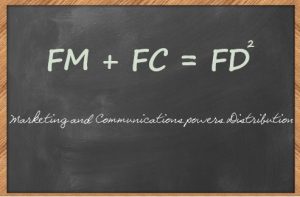Fund distribution plays an enormous role in the success of an investment fund. But what often overlooked elements play an enormous role in successful fund distribution? The answer is fund marketing and fund communications. Strong marketing and communications strategies create strong distribution. Cut distribution open and it bleeds marketing and communications. Most asset managers refer to fund distribution as fund marketing but it’s vital to differentiate and understand each component.
 Fund Marketing
Fund Marketing
Traditionally, fund prospectuses are seen as the main way to reach the investor by fund managers. And often oblige by sending out large, bland, monotonous and indigestible documents. On average, institutional investors receive 45 prospectuses a quarter and 10% receiving more than 100. Only 15% of these get passed the initial filtering stage. Less than 0.2% are actually successful in attaining investment. Pdf’s are being ripped from emails by many company firewalls and the hassle for the investor to have the pdf released becomes another boundary to penetration. Is it any wonder we are starting to hear slogans such as ‘Death to Pdf 2016!’ and ‘We are pdf deaf!’. In this post AIFMD world using ‘push’ marketing across global markets is an expensive way to attain very low penetration.
To overcome you must adapt. A dynamic fund marketing strategy will steer the fund toward reverse solicitation, inbound rather than push marketing. Spray and pray marketing is not effective. Those achieving the highest rates of penetration now rely on a strong brand and make the most of their marketing assets such as their website and reach prospects through video, webinars and social media. Many funds build a website on the premise that ‘my competitors have one so I got one’. The function of the website must be addressed. It can be a revenue generator, a communications tool, a value add to clients/investors. Asset managers are adopting social media as regulatory groups recognise it as suitable means to communicate. Social media can help create communities, promote without bombarding, become a thought leader or a subject authority.
Fund Communications
A fund is required to put out communications to stakeholders to satisfy fiduciary, regulatory and legal obligations. You don’t have to see this as an administrative drudge; a fund can use these obligations to strengthen your relationship with the investor and other parties. Change communications strategy regarding compliance to an open, transparent and well designed communication to investors. For example, with 54% of investors unhappy with the level of provided transparency compared to 78% of fund managers who believe they provide enough, create competitive advantage by addressing this clear disconnect. Speak the investors’ language, let them see how well the fund is being managed and see the relationship solidify. There is plenty of scope for this;
- NAV publication
- Meeting requirements in relation to Key Investor Information Documents (KIIDS) being provided to investors before they invest in a UCITS
- Publication of semi-annual and annual financial statements
- Shareholder notifications
- Notices for Shareholder General Meetings
- Key performance indicators such as investment performance versus benchmark
The fund’s message must be consistent across all mediums to avoid confusion and keep focus on the core message. The smart fund manager will deliver messages about updates and services through social media, the website, intranets, extranets. It is advisable to communicate regularly and stay in line with the investment philosophy and the strategy of the firm, this helps provide a ‘true to label’ comfort level for the client/investor. At all times funds must ensure that their communications are fully compliant.
Fund Distribution
The asset manager’s distribution strategy should include fund marketing, fund communication, knowledge of distribution channels and regulation.
Knowledge of the distribution channels per targeted jurisdiction is of course vital for building an effective distribution strategy. Each market differs from the next in terms of public offering listing, regulated public distribution, private placement, local distribution networks, regulatory requirements and more. The distribution network is still viewed as complex and somewhat opaque. A fund should make sure to complete full due diligence on the distribution network and on would be distribution partners. It is essential that the transfer agent and distributor used have solid know-your-customer and anti-money laundering procedures. From there the fund needs to grow a strong relationship with the local distributors and agents on a business and operations level.
Complying with local regulatory requirements is an area that needs constant supervision as regulations are constantly changing. Asset managers working with fund lawyers will need to get to grips with regulatory requirements on local agents, eligibility, investor disclosure, registration and continued registration, and marketing.
An adept asset manager will be looking at what the future holds for the industry and will have the fund prepared. For the near future in the asset management sector we can see the following:
- An almost complete move from the traditional style of marketing to digital marketing. And the ‘Death of PDF’ in 2016.
- An even greater evolution of fund products to match investor demand
- The emergence of new distribution channels
- The wide use of video to engage prospects taking into account the IT savvy nature of the ‘next generation of investors’
In summary
Fund distribution is not complete without fund marketing and fund communication. These two components are often neglected and thus can result in the fund making a negative impression unbeknownst to the fund manager. In a congested sector, of over 25,000+ funds, investing in marketing and communication post AIFMD is critical. It is no coincidence that the most successful funds have strong brands and use communication strategy as a competitive advantage. Having a strong brand and identity helps strengthen the trust between investor and the fund. Strong communication strategy strengthens the relationship between the investor and the fund. Thus building a solid platform to increase the reach of fund distribution.
Ken Carmody kmc@finscoms.com

